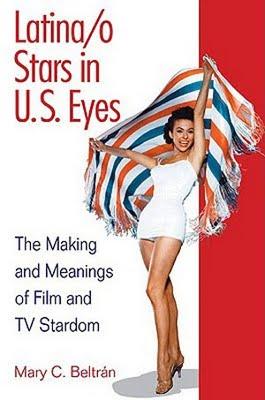Latina/o Stars in U.S. Eyes: The Making and Meanings of Film and TV Stardom

Beltrán’s study about Latina/o actors’ contributions to U.S. film, TV, and popular culture is illuminating and very well organized, researched, and written. The writer has explored and conveyed to us an abbreviated overview of the historical evolution of Latina/o representation and stardom in Hollywood films and U.S. television; major components of what she terms “Hollywood Latinidad.”
The growing role and influence in complex cultural productions in the United States stems also from the steadily growing Latino populations in the United States. In the 1960s Latino population was 4.5% of all the citizens of the States; in 2008 it has increased to fifteen percent or more than one in seven in the population of United States.
Latinos are becoming increasingly visible and influential in popular culture yet there has always been a hint of marginalization. Most carry labels of “the Latin lover,” “bandito” and “spitfire” amongst others. Yet Latin actresses and actors portray richly textured characters and consequently Latina/o opportunities for stardom (stardom meaning the object of public fascination) are slowly increasing. Stars are viewed as role models especially for young people, they are supposed to help establish social attitudes amongst U.S. citizens. The study is divided into seven chapters: the first chapter with its spicy title “Latin Lovers and American Accents: Dolores Del Río and Hollywood’s Transition to Sound,” Beltrán explores the rare opportunities that benefited a handful of Latina/o actors in the 1920s.
Next three chapters, namely “The Good Neighbour and Prime Time: Desi Arnaz and I Love Lucy,” “A Fight for ‘Dignity and Integrity’: Rita Moreno in Hollywood’s Postwar Era” and “The Burden of Playing Chico: Freddie Prinze and Latino Stardom in Television’s Era of ‘Relevance’” explore Latina/o opportunities and star promotion during the 1950s, 1960s and 1970s.
Chapter five “The Face of the ‘Decade’: Edward James Olmos and Latino Films of the 1980s” focuses on shifts in Hollywood’s structure of Latinidad as Latina/o filmmakers began to have an impact on a national level.
The remaining two chapters “Crossing Over the Latina Body: Jennifer Lopez and the 1990s ‘Latin Wave’” and “Ethnic Ambiguity in the Era of Dark Angels: Jessica Alba and Mixed Latina/o Trends” analyze star promotion in relation to the career and development from Latin star image during their rise to mainstream stardom. Without doubt, this study is a successful attempt to reach students from film and media studies, students of Spanish and Latin American studies and all others interested in the notion of culture. Equally, it is an indispensable tool in the classroom for any instructor passionate about delivering interactive seminars about the evolution of Latina/o national identity since the silent film era.